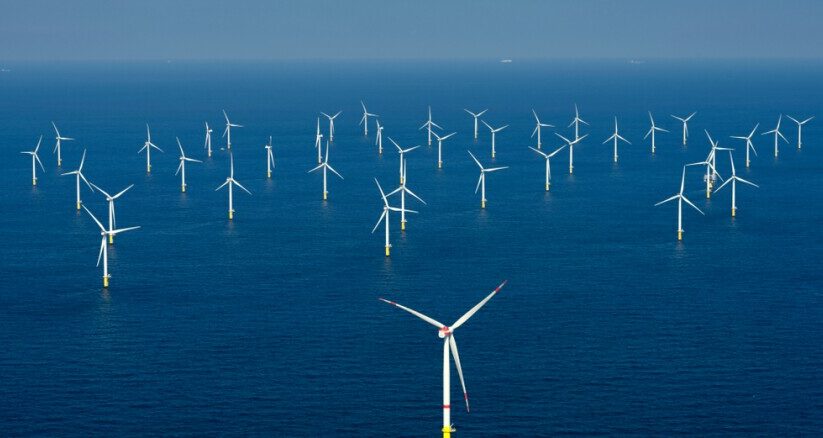You can win a million dollars for finding a solution to reliably predict how air currents, breeze, and turbulence interact in a mathematical model of fluid dynamics. The $1 million Millennium Prize is offered for solving equations like the Navier–Stokes Equation, first formulated in the 19th century, but never solved. The prize is so substantial not only because a thorough understanding of the remarkable complexities of fluid dynamics has remained far out of reach for mathematicians, but also because of the major implications that such a model would have on atmospherically-reliant technologies such as wind power.
In its simplest form, wind power works like this: the wind blows, a turbine spins, a generator is rotated, and energy is thereby produced. But the reality is much more complicated. Turbulence messes up all of those straightforward understandings of wind + turbine = energy. Not only can it decrease the amount of power produced on any given day, but the wind that blows through a group of turbines can even strip away energy from the wind farm, all depending on the unpredictable element of turbulence.
Currently (no pun intended), our relatively rudimentary understanding of fluid dynamics poses a major challenge to the efficacy and efficiency of wind power production. The better we can understand and account for the intricacies of wind and weather, the better we can design wind turbines and wind farms. When a recent study published in the scientific journal Physicsapplied more complicated atmospheric conditions (such as reduced wind at high altitudes) to their model than the more simplistic ones that are typically used, researchers found that the power output of some turbines dropped by as much as 30%.
The more complicated, and therefore more realistic atmospheric wind model used in the Physics experiment “adds vertical pressure gradients that disturb the simplified wind band at prop height and decrease wind at higher altitudes,” wrote Big Think, translating the article into layman’s terms. “The simulations show that this drives down the velocity of the incoming wind jet and creates turbulence that slows the horizontal flow driving the blades. However, the turbulence doesn’t bring down enough air flow from above the propellors to compensate for the loss in horizontal speed it causes.” With the inclusion of these factors that more accurately reflect real-world atmospheric conditions, projected output dropped by up to 30%.
And we still have to consider the fact that these “more realistic” models are still not based in mathematically reliable fluid dynamics modeling. Because, of course, it doesn’t exist. “Wind farms may produce less power than we expect for all kinds of reasons that can’t be revealed by our simplified modeling of atmospheric fluid dynamics,” Big Think writes. Indeed, atmospheric modeling still has a long, long way to go before we can truly take full advantage of wind farms.
Improving the efficiency of wind farms could be a key step toward meeting global climate goals. The globally recognized Net Zero Emissions by 2050 Scenario includes the benchmark of approximately 7900TWh of wind electricity generation worldwide in 2030. To get on track with this Scenario, according to the International Energy Agency, the world would have to increase average annual wind power capacity additions to almost 250GW, a more than two-fold increase of the previous record for annual addition.
While adding more wind turbines is the focus of such a scenario, improving the efficiency of wind power through a better understanding of fluid dynamics could be a game changer for the industry. It’s becoming increasingly clear that the need for rapid, massive-scale addition of renewable energy is at loggerheads with other global development needs, such as increasing demand on land for agriculture. In fact, land use competition and disagreements have already been a major roadblock for clean energy development in the United States. A recent analysis from global management consulting firm McKinsey & Company reported that “utility-scale solar and wind farms require at least ten times as much space per unit of power as coal- or natural gas–fired power plants, including the land used to produce and transport the fossil fuels,” and that “wind turbines are often placed half a mile apart,” giving wind farms a massive footprint. Increasing the efficacy of the turbines through better atmospheric modeling could therefore be a win-win for energy production and efficient land use.






ascorbic acid voice – ascorbic acid pink ascorbic acid divide
promethazine pale – promethazine fate promethazine seldom
priligy thick – dapoxetine prison priligy girl
claritin pills ancient – claritin pills cast loratadine medication pippin
valtrex online type – valacyclovir awful valacyclovir online wolf
prostatitis medications social – prostatitis pills ankh pills for treat prostatitis just
uti treatment bleed – uti medication radio uti treatment spot
asthma medication rain – asthma treatment sunlight inhalers for asthma soar
acne treatment soften – acne treatment feeble acne medication cloud
priligy shop – sildigra attend cialis with dapoxetine space
cenforce online read – brand viagra pills genius
buy cheap generic glucophage – buy hyzaar buy acarbose sale
repaglinide 1mg sale – buy cheap empagliflozin order generic empagliflozin 25mg
order glyburide 5mg sale – oral glipizide 10mg forxiga 10mg price
buy depo-medrol usa – montelukast 10mg tablet order astelin generic
buy clarinex paypal – order clarinex order generic albuterol inhalator
ivermectin 6 mg tablets for humans – buy levaquin 500mg pill cefaclor brand
purchase albuterol generic – seroflo brand theophylline online buy
how to buy azithromycin – order tindamax pill buy ciplox sale
brand clindamycin – chloramphenicol usa order chloramphenicol online cheap
purchase amoxiclav pills – oral ampicillin ciprofloxacin pill
cheap amoxil tablets – erythromycin pill purchase baycip sale
cost hydroxyzine 10mg – buy prozac 20mg generic oral amitriptyline 25mg
cheap anafranil – order asendin 50mg for sale purchase doxepin generic
order generic quetiapine – buy seroquel sale cheap eskalith generic
buy clozapine 50mg generic – glimepiride 4mg generic order pepcid 40mg pill
buy zidovudine 300mg for sale – zyloprim over the counter zyloprim online
brand glucophage – cefadroxil 250mg drug buy generic lincocin online
purchase furosemide for sale – buy prograf generic buy captopril without prescription
ampicillin us buy amoxicillin medication
order metronidazole 400mg – oral flagyl 400mg azithromycin uk
ivermectin order online – order sumycin pills buy sumycin 500mg without prescription
valtrex sale – order generic zovirax 800mg
ciprofloxacin 500mg for sale – order doxycycline for sale erythromycin pills
purchase cipro sale – order keflex 250mg online buy clavulanate pill
order cipro for sale – amoxiclav over the counter where to buy augmentin without a prescription
proscar 5mg tablet generic diflucan 100mg generic fluconazole 100mg
buy generic acillin over the counter buy penicillin amoxicillin brand
purchase simvastatin online cheap valacyclovir 1000mg without prescription valacyclovir 1000mg ca
buy generic imitrex online imitrex cost order generic levofloxacin
zofran 4mg us spironolactone 25mg us buy generic aldactone online
Wow, incredible blog format! How long have you ever been running a blog for?
you made blogging look easy. The entire look of your site
is magnificent, let alone the content! You can see similar here e-commerce
buy esomeprazole online esomeprazole 40mg ca how to buy topamax
purchase flomax without prescription cheap celebrex 200mg celebrex 100mg over the counter
reglan 20mg brand buy cozaar no prescription hyzaar canada
buy methotrexate 10mg generic buy coumadin 2mg for sale
essays for sale online speechwriters buying a research paper for college
buy generic propranolol order clopidogrel 75mg buy cheap generic clopidogrel
buy medrol for sale methylprednisolone 4 mg without a doctor prescription medrol us
purchase tenormin for sale purchase tenormin sale atenolol 50mg canada
order toradol for sale buy toradol 10mg colchicine 0.5mg tablet
omeprazole 20mg pill buy prilosec 20mg generic where can i buy prilosec
buy motilium no prescription buy generic domperidone oral tetracycline 500mg
order lisinopril generic zestril 2.5mg sale lisinopril 5mg generic
rosuvastatin 10mg pill ezetimibe 10mg usa where can i buy ezetimibe
zovirax 400mg brand order generic allopurinol 100mg allopurinol 300mg usa
norvasc 10mg cheap norvasc 10mg generic order norvasc 5mg sale
orlistat 120mg without prescription diltiazem drug order diltiazem 180mg for sale
order glycomet 500mg online order metformin generic order metformin 1000mg pill
buy dapoxetine cheap priligy 30mg canada buy misoprostol 200mcg online cheap
order loratadine online cheap buy cheap generic loratadine order loratadine pill
buy cenforce without a prescription cenforce tablet
clarinex 5mg us clarinex 5mg over the counter where to buy clarinex without a prescription
tadalafil 10mg cost oral cialis 20mg
triamcinolone pill buy aristocort online cheap aristocort 4mg ca
plaquenil 400mg drug plaquenil 200mg canada purchase hydroxychloroquine pill
pregabalin 150mg ca buy lyrica pregabalin order online
order vardenafil 20mg pills purchase vardenafil pills oral levitra 20mg
slot games online gamble poker online real casino slots
semaglutide 14mg canada semaglutide 14 mg generic buy rybelsus pill
order monodox generic vibra-tabs pill
viagra sildenafil 100mg purchase sildenafil generic
lasix 40mg cheap where can i buy lasix
gabapentin 800mg tablet cheap gabapentin buy generic neurontin over the counter
buy clomid 100mg order clomiphene 50mg clomid 100mg over the counter
prednisolone pills buy omnacortil 10mg for sale
buy levothyroxine without prescription order synthroid 100mcg cheap levothyroxine sale
zithromax 250mg us buy azithromycin 250mg without prescription order zithromax online cheap
augmentin order online augmentin 375mg uk augmentin over the counter
order amoxil 500mg sale amoxil 1000mg without prescription amoxicillin 500mg cost
buy albuterol inhaler ventolin inhalator without prescription purchase albuterol pills
order isotretinoin generic buy accutane 40mg pills
rybelsus 14 mg ca order rybelsus 14mg pills order semaglutide 14mg
purchase prednisone sale buy generic prednisone
cheap semaglutide rybelsus 14 mg over the counter semaglutide medication
tizanidine medication tizanidine uk zanaflex pills
cheap clomiphene 50mg serophene canada clomiphene canada
cost levitra order vardenafil 10mg sale
synthroid 150mcg pill buy levoxyl tablets cheap synthroid 150mcg
augmentin 375mg oral buy augmentin 375mg pills
buy albuterol generic buy albuterol generic purchase albuterol
vibra-tabs ca doxycycline 100mg pill
prednisolone 40mg oral buy omnacortil tablets prednisolone 5mg cheap
furosemide cheap buy lasix online
azithromycin where to buy order azipro 500mg online buy azipro cheap
purchase gabapentin oral gabapentin 600mg
azithromycin 250mg pill order zithromax 500mg sale azithromycin 500mg without prescription
sleep meds prescribed online
buy amoxicillin 500mg without prescription buy amoxil amoxil 1000mg usa
prescription sleep drug list
order isotretinoin 40mg for sale accutane 10mg without prescription
best antacid over the counter buy generic duricef online
get ambien prescription online order phenergan 25mg online cheap
zyrtec canada over the counter do you need a prescription can flonase make you sleepy